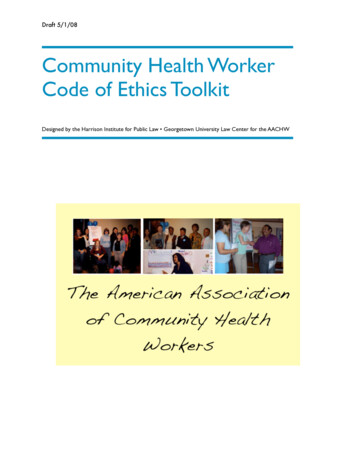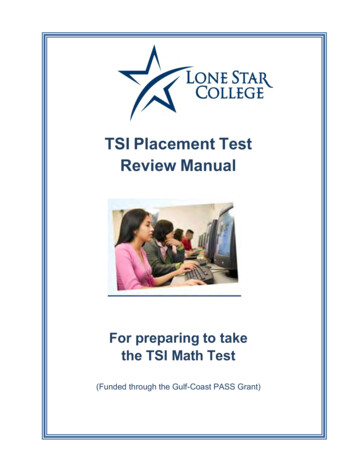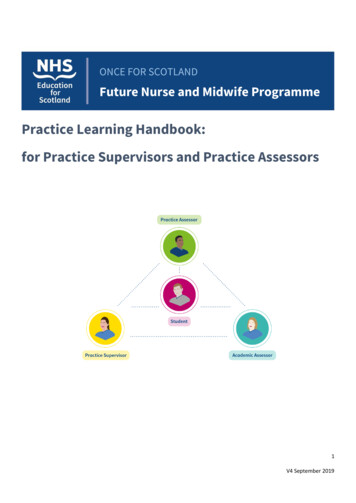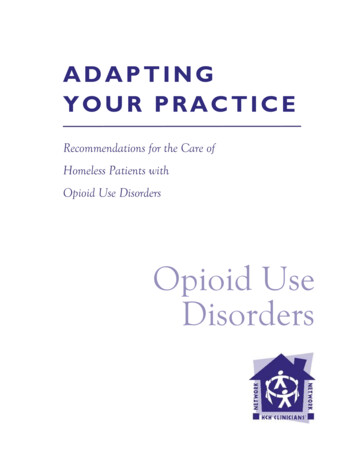
Transcription
ADAPTINGYOUR PRACTICERecommendations for the Care ofHomeless Patients withOpioid Use DisordersOpioid UseDisorders
March 2014ADAPTING YOUR PRACTICERecommendations for the Care ofHomeless Patients withOpioid Use DisordersHealth Care for the HomelessClinicians’ NetworkMarch 2014
Health Care for the Homeless Clinicians’ NetworkAdapting Your Practice: Recommendations for the Care of Homeless Patients with Opioid Use Disorders wasdeveloped with support from the Bureau of Primary Health Care, Health Resources and ServicesAdministration, U.S. Department of Health and Human Services.All material in this document is in the public domain and may be used and reprinted withoutspecial permission. Citation as to source, however, is appreciated. Suggested citation:Meges D, Zevin B, Cookson E, Bascelli L, Denning P, Little J, Doe-Simkins M, Wheeler E, WatlovPhillips S, Bhalla P, Nance M, Cobb G, Tankanow J, Williamson J, Post P (Ed.). Adapting YourPractice: Recommendations for the Care of Homeless Patients with Opioid Use Disorders. 102 pages.Nashville: Health Care for the Homeless Clinicians' Network, National Health Care for theHomeless Council, Inc., 2014.DISCLAIMERThis publication was made possible by grant number U30CS09746 from the Health Resources &Services Administration, Bureau of Primary Health Care. Its contents are solely the responsibility ofthe authors and do not necessarily represent the official views of the Health Resources & ServicesAdministration.iADAPTING YOUR PRACTICERecommendations for the Care of Homeless Patients with Opioid Use Disorders
Health Care for the Homeless Clinicians’ NetworkPREFACEClinicians experienced in homeless health care routinely adapt their practice to foster betteroutcomes for their patients. This document was written for health care professionals, programadministrators, other staff, and students serving individuals with opioid use disorders who arehomeless or at risk of homelessness. Its purpose is to improve patient care by enhancingunderstanding of recommended strategies for the successful treatment and management of opioiduse disorders in marginalized populations.Standard clinical guidelines often fail to take into consideration the unique challenges presented byhomelessness that may limit access to needed services or adherence to a plan of care. To address thisoversight, the Health Care for the Homeless (HCH) Clinicians’ Network has made the developmentof recommended clinical practice adaptations for the care of people experiencing homelessness oneof its top priorities. Since 2002, the HCH Clinicians' Network has developed and revised nine priorsets of recommendations for the management of health problems that are common among homelesspeople and particularly challenging for their caregivers. These recommendations are available at:www.nhchc.org and www.guideline.gov.The need for adapted practice guidelines for the care of individuals with opioid use disorders andunstable living situations was prompted by a significant increase in deaths from opioid overdosereported nationwide, particularly among people experiencing homelessness. The project waslaunched at a meeting of the HCH Clinicians’ Network (CN) in October 2012, held in Nashville,TN. The CN Steering Committee decided to form an addiction medicine taskforce whose primaryfocus would be the development of adapted practice guidelines for homeless patients. In 2013, anadvisory committee comprised of 14 health and social service providers experienced in themanagement of addiction disorders for underserved populations was convened to develop clinicaland programmatic recommendations for the care of homeless people with opioid dependence.These recommended practice adaptations reflect their collective judgment about optimal medicaland non-medical interventions for this population.The recommendations in this document specify what experienced providers and recipients ofhomeless services believe works best, with the realistic understanding that limited resources,fragmented health care delivery systems, and loss to follow-up often compromise adherence tooptimal clinical practices. We hope these recommendations provide helpful guidance to health careprofessionals, and that they will contribute to improvements in both quality of care and quality oflife for people experiencing homelessness.Patricia A. Post, MPA (Editor)Health Care for the Homeless Clinicians’ NetworkADAPTING YOUR PRACTICE:Recommendations for the Care of Homeless Patients with Opioid Use Disordersii
Health Care for the Homeless Clinicians’ NetworkAUTHORSAdvisory Committee on Adapting Clinical Practice for the Care of Homeless Patients withOpioid Use DisordersDaniel Meges, MD, FACP (Chair)Medical Director, Care Alliance Health CenterCleveland, OHLynda Bascelli, MDMedical Director, Project H.O.P.E.(Homeless Outreach Program Enrichment)Camden, New JerseyPooja Bhalla, RN, BSNProgram Director of Nursing & AssociateDirector Clinical OperationsBoston Health Care for the Homeless ProgramBoston, MassachusettsGary CobbPeer Mentor & Community ActivistCentral City ConcernPortland, OregonSue Watlov Phillips, MAPresident and CEOIntegrated Community SolutionsMinneapolis, MinnesotaJay Tankanow, LSWConsumer advisory board memberBoston Health Care for the Homeless ProgramBoston, MassachusettsEliza Wheeler, MPAProject Manager, Drug Overdose Prevention andEducation (D.O.P.E.) programHarm Reduction CoalitionOakland, CaliforniaElizabeth Cookson, MD, DFAPADirector of PsychiatryColorado Coalition for the HomelessDenver, ColoradoMaya Doe-Simkins, MPHTraining & Technical Assistance ManagerMidwest Harm Reduction InstituteHeartland Health OutreachChicago, IllinoisJeannie Little, LCSW, Executive DirectorPatt Denning, PhD, Director Clinical Services& TrainingThe Harm Reduction Therapy CenterSan Francisco, CaliforniaiiiMichelle Nance, NP, RN, MSNNurse Practitioner, San Francisco Dept. of PublicHealth Housing & Urban Health Clinic;San Francisco Medical Respite ProgramSan Francisco, CaliforniaJames Williamson, MS, PA-CPhysician AssistantGolden Valley Health CentersRipon, CaliforniaBarry Zevin, MDPhysician Specialist in Addiction MedicineTom Waddell Health CenterSan Francisco Department of Public HealthSan Francisco, CaliforniaPatricia A. Post, MPAEditor, Adapting Your Practice seriesHCH Clinicians’ NetworkNational Health Care for the Homeless CouncilNashville, TennesseeADAPTING YOUR PRACTICE:Recommendations for the Care of Homeless Patients with Opioid Use Disorders
Health Care for the Homeless Clinicians’ NetworkACKNOWLEDGEMENTSThe individuals listed above were primarily responsible for the development of recommendationscontained in these supplemental guidelines. These dedicated service providers and recipients gavegenerously of their time to formulate guidance for practitioners less experienced in the care of patientswhose comorbidities and limited resources, both financial and social, are among the causes andconsequences of homelessness.In addition, the Advisory Committee would like to thank the following individuals for reviewing andcommenting on draft recommendations prior to publication: Diana Amodia MD, Medical Director, BAART Turk Street Clinic, San Francisco, CaliforniaJudith Martin MD, Deputy Medical Director of Community Behavioral Health Services,Medical Director of Substance Use Services, Department of Public Health, City and County of SanFrancisco, San Francisco, CaliforniaSharon Stancliff MD, Medical Director, Harm Reduction Coalition, New York, New YorkAlexander Y Walley, MD, MSc, Assistant Professor of Medicine, Clinical Addiction Research andEducation Unit, Boston Medical Center /Boston University School of Medicine, Boston,MassachusettsAnsell Horn, FNP, Nurse Practitioner, Lutheran Family Health Centers, Brooklyn, New YorkMindy Butler, RPh and Cathy Rakers, RPh, Pharmacists, Outside In, Portland, OregonThis document is dedicated to the memory of Jay Tankanow, LSW, a member of the Advisory Committee onAdapting Clinical Practice for the Care of Homeless Patients with Opioid Use Disorders who passed away before theproject's completion, but not before he had contributed valuable insights that are reflected in these recommendedpractice adaptations.For most of his career, Jay worked in the human services field, first as an emergency medical technician and then as asocial worker for the Massachusetts Department of Mental Health, running dual diagnosis programs dealing with mentalillness and addiction therapy. He was also an ardent consumer advocate in campaigns promoting patient safety throughthe use of medications like naloxone (Narcan ), which can help to prevent opioid overdose deaths. He worked withthe Boston Health Care for the Homeless Program's Consumer Advisory Board for eight years on efforts to reducemedical emergencies as a result of prescription drug misuse, and served on the National Health Care for the HomelessCouncil's Policy Committee.It is the policy of the National Health Care for the Homeless Council to require authors of its educationalpublications to disclose financial relationships with relevant commercial entities and to identify and resolveany related conflicts of interest. The authors of this document reported no such relationships or conflicts ofinterest. The content of this document is educational and based on clinical experience or rigorous scientificevidence. It was developed independent of commercial influence.ivADAPTING YOUR PRACTICERecommendations for the Care of Homeless Patients with Opioid Use Disorders
Health Care for the Homeless Clinicians’ NetworkTable of ContentsSUMMARY OF MAJOR RECOMMENDATIONS1INTRODUCTION4DIAGNOSIS & EVALUATIONHistoryPhysical ExaminationDiagnostic Testing & Assessment91415PLAN & MANAGEMENTPlan of CareEducation, Self-ManagementTreatment, ManagementAssociated Problems, ComplicationsFollow-up1923285156MODEL OF CAREService Delivery DesignOutreach and EngagementStandards of Care586164CASE STUDIESTreatment Selection for Patients with Opioid Use DisorderCountering Myths about Methadone Maintenance Treatment6667SOURCES & RESOURCESPrimary SourcesReferences on Homeless/ Underserved PopulationsOther ReferencesSuggested ResourcesWebsitesAbout the HCH Clinicians’ NetworkAPPENDIX82A. Harm Reduction Principles & Therapy by Patt Denning & Jeannie Little, Harm83Reduction Center, San Francisco, CaliforniaB. Worksheet for DSM–5 criteria for Diagnosis of Opioid Use DisordersC. Albuquerque Health Care for the Homeless Re-Entry Collaborative Fact SheetD. Potential Interactions with Drugs of Abuse by Mindy Butler, RPh & Cathy Rakers,RPh, Outside In, Portland, Oregonv686873808181909295ADAPTING YOUR PRACTICERecommendations for the Care of Homeless Patients with Opioid Use Disorders
Health Care for the Homeless Clinicians’ NetworkSummary of Recommended Practice AdaptationsFor the Care of Homeless Patients with Opioid Use Disorders:These recommendations of the HCH Clinicians’ Network were approved by the Advisory Committee on AdaptingClinical Practice for Homeless Patients with Opioid Use Disorders, whose members have expertise in homelesshealth care, primary care, addiction medicine, psychiatry, harm reduction therapy, and drug overdose prevention.Recommended Clinical Adaptations:HISTORY Use clinical history-taking as a critical opportunity to engage the patient and establish trust; focus on fosteringa positive, mutually respectful relationship between the provider and patient.Ask about physical and mental health and history of drug use, beginning with open-ended questions. Askabout personal experience as an overdose survivor and witness, including manifestations of overdose relatedtrauma.Ask about cultural background, living situation, history of trauma/abuse, and legal problems.PHYSICAL EXAMINATION Look for physical evidence of opioid use, intoxication, or withdrawal.Look for signs of skin and soft tissue infection; test for HIV/HBV/HCV infection and end-organ damageincluding liver failure.Look for indications of severe depression, suicidal intent, cognitive disorders, and sequelae of trauma/abuse.DIAGNOSTIC TESTING & ASSESSMENT Test patients for comorbidities that are strongly associated with opioid use disorders, including polysubstanceuse and sexually transmitted/ bloodborne infections.Evaluate findings from the clinical history, physical exam, and diagnostic testing to determine diagnosis andseverity of opioid use disorder; identify any contraindications to medication-assisted treatment or acuteconditions requiring a higher level of care.PLAN OF CARE Work collaboratively with patients to develop realistic, attainable, short-term goals for the management of opioiduse disorders, including a personalized overdose risk reduction plan and other harm reduction strategies.Determine treatment approach and setting based on patient needs and preferences, available resources, andaffordability. Also consider motivations for seeking care, previous treatment experience, duration of disorder atcurrent severity, use of heroin vs. pills, method of use, source of opioids (prescribed vs. illicitly obtained), and cooccurring disorders.Plan for close follow-up by a case manager and regular diagnostic evaluation with allowance for frequent andunscheduled visits.EDUCATION, SELF-MANAGEMENT Review fundamental concepts of opioid use disorder management (treatment alternatives, side effects, risksand benefits); teach clients who are actively using opioids how to practice harm reduction; teach thosecurrently abstaining to recognize signs and symptoms of relapse.Provide opioid safety education to all patients with substance use disorders and to patients taking opioidanalgesics on the effects of opioids, including the possibility of overdose and interactions of opioid agonistswith other medications/ drugs of abuse.1ADAPTING YOUR PRACTICERecommendations for the Care of Homeless Patients with Opioid Use Disorders
Health Care for the Homeless Clinicians’ Network Educate patients about overdose risks, recognition and response. Offer naloxone (if possible) to any patientundergoing tolerance changing events such as medically supervised withdrawal procedures or medicationassisted treatment induction.Utilize tools such as motivational enhancement techniques and brief office-based counseling to help assesspatients’ level of readiness for behavioral change.TREATMENT, MANAGEMENT Offer medication-assisted treatment to any patient with an opioid use disorder.Encourage use of nonpharmacologic interventions, whether patients are receiving medication-assisted treatment ornot: harm reduction therapy, peer mentoring, peer support groups, acupuncture, and stable housing with access tosupportive services including employment assistanceOffer needle exchange and naloxone to individuals using injected opioids, to the extent permitted by law andavailable resources.Encourage more physicians serving homeless and other disadvantaged populations to seek training andcertification to prescribe buprenorphine.Encourage more primary and specialty care providers serving homeless and other disadvantaged populations tocollaborate and integrate care with addiction treatment programs, including methadone maintenance anddetoxification programs.Develop more directly observed therapy (DOT) programs to monitor use and avoid misuse/ diversion of opioidagonist medications.ASSOCIATED PROBLEMS, COMPLICATIONS Carefully assess for comorbidities that can complicate or interfere with treatment of opioid use disorders.Manage co-occurring conditions simultaneously.Provide opioid safety education on the effects of opioids including the possibility of overdose to all patientswith a history of substance use and to patients taking opioid medications for pain management.Institute regular monitoring of all medications prescribed for and taken by the patient to prevent prescriptionof lethal or nontherapeutic medication combinations and to reduce risk of prescribing medications that willtrigger relapse in patients with substance use disorders.If diversion/misuse of opioid agonists is suspected, explore patient motivations; re-evaluate the plan of care;implement strategies to minimize risk of diversion/ misuse (random drug tests, alternate day dosing,prescription monitoring program, directly observed therapy). Balance overall benefits of continuing MATwith potential harms.FOLLOW-UP Determine frequency of follow-up based on stability of the patient and his/her living situation and risk ofdiversion/ misuse/ abuse of medications used for treatment of opioid use disorders or other substances.At each visit, assess for behaviors outside the treatment plan, including a psychosocial assessment. Considercauses related to homelessness — missed appointments due to competing priorities or unexpected events (e.g.,in jail, delayed by another appointment), stolen medications (e.g., assault, theft in shelter).Provide medical respite care facilities where patients can convalesce when ill, recuperate followinghospitalization, or receive end of life care. Facilitate entry into permanent housing with supportive services onsite or in the community, to alleviate many associated problems and complications.ADAPTING YOUR PRACTICE:Recommendations for the Care of Homeless Patients with Opioid Use Disorders2
Health Care for the Homeless Clinicians’ NetworkRecommended Programmatic Adaptations:SERVICE DELIVERY DESIGN Design service delivery systems based on meeting patient needs, promoting consistency in practice, andsupporting staff that work with challenging patients.Consider use of unconventional treatment sites (e.g., mobile methadone vans), addiction counseling on adrop-in basis, flexible treatment goals and desired outcomes, and creative strategies for recruiting patientsinto treatment.Establish collaborative relationships with methadone maintenance providers, detoxification programs, andother inpatient and outpatient addiction treatment programs for cross referral and coordinated care.Integrate primary and behavioral health care and use a harm reduction approach to the management ofopioid use disorders. Use multidisciplinary clinical teams working at the same location. Locate treatmentactivities in places where homeless individuals with substance use disorders congregate. Provide recoveryoriented support services (e.g., peer mentoring, group therapy, employment assistance).OUTREACH AND ENGAGEMENT Use outreach workers in the community to facilitate initial engagement with and provide support to peopleat risk for opioid overdose. Do outreach in partnership with a consumer/peer counselor as much as possible.Provide ongoing opportunities for group therapy to patients with opioid use disorders.If possible, provide medication-assisted treatment where homeless people live (e.g., shelter-based treatmentwith buprenorphine).Use a team approach in care planning and coordination to facilitate engagement.STANDARDS OF CARE Adapt clinical practices to optimize care for patients who are homeless or at risk of becoming homelessconsidering the recommendations contained in this guide.Offer medication-assisted treatment to any patient with an opioid use disorder.Address acute and chronic medical problems related to drug use.Offer naloxone to patients with an opioid use disorder and offer needle exchange to injecting drug users, tothe extent permitted by law and available resources.Advocate for improved access for homeless and other underserved populations to a broader range ofinterventions for the management of opioid use disorders.3ADAPTING YOUR PRACTICERecommendations for the Care of Homeless Patients with Opioid Use Disorders
Health Care for the Homeless Clinicians’ NetworkINTRODUCTIONOpioids are opium derivatives and related synthetic substances that suppress pain, produce euphoria,and are employed to treat neurological and behavioral disorders resulting from opioid misuse.Although they are invaluable therapeutic agents, these powerful drugs are also addictive; andmedication errors, misuse, overdose, and poisonings cause numerous fatalities annually. Illicit use ofopioids – both heroin and prescribed analgesics such as oxycodone, hydrocodone, and fentanyl – hasreached epidemic proportions in the United States (Preda & Dunayevich 2013, SAMHSA 2012 Sep,Alford 2007). In 2008, over 36,000 people died in the U.S. as a result of drug overdose. The majority ofthese deaths involved prescription opioid analgesics (CDC 2011). Opioid use disorders1 occur along acontinuum of severity, with different patterns of use in urban and rural areas and within differentsubpopulations – e.g., more heroin use in urban areas, involving older, more ethnically diverse users;more non-heroin opioid use in rural areas by younger, non-Hispanic Whites (SAMHSA 2012 Jul).Opioid use is frequently a component of polysubstance use disorders.Opioid poisonings and overdose deaths occur throughout all segments of society, but clinicians servingpeople who are homeless2 or unstably housed report that these individuals are at especially high risk forboth opioid use disorders and fatal overdoses, exacerbated by their limited access to medication-assistedtreatment and to overdose prevention therapy (HCH Clinicians’ Network 2006 Oct & 2009 Feb). Afive-year study of 28,033 homeless people who had received treatment from the Boston Health Care forthe Homeless Program between 2003 and 2008 found that drug overdose had replaced HIV as theleading cause of death among homeless adults in Boston and was responsible for one-third of fatalitiesof those between the ages of 25 and 44. Opioid analgesics and heroin were implicated in 81% ofoverdose deaths. Homeless adults aged 25–44 were nine times more likely to die than comparably agedhoused adults in Massachusetts, and those aged 45–64 were 4.5 times more likely to die. (Baggett 2013).1Opioid use disorder: “A problematic pattern of opioid use leading to clinically significant impairment or distress,” asmanifested by at least two of 11 diagnostic criteria specified in the American Psychiatric Association's Diagnostic andStatistical Manual of Mental Disorders, Fifth Edition (DSM-5), 2013. Severity of the DSM-5 substance use disorders is basedon the number of criteria endorsed: 2–3 criteria indicate a mild disorder; 4–5 criteria, a moderate disorder; and 6 ormore, a severe disorder.2A homeless person, as defined by the Bureau of Primary Health Care, is “ an individual without permanent housingwho may live on the streets; stay in a shelter, mission, single room occupancy facility, abandoned building or vehicle; or inany other unstable or non-permanent situation. An individual may be considered to be homeless if that person is ‘doubledup,’ a term that refers to a situation where individuals are unable to maintain their housing situation and are forced tostay with a series of friends and/or extended family members. In addition, previously homeless individuals who are to bereleased from a prison or a hospital may be considered homeless if they do not have a stable housing situation to whichthey can return. A recognition of the instability of an individual's living arrangement is critical to the definition ofhomelessness.” [emphasis added] (Principles of Practice: A Clinical Resource Guide for Health Care for the Homeless Programs,Bureau of Primary Health Care/HRSA/HHS, 3/1/99; PAL 99–12.) [The authors of these adapted practice guidelinesunderstand that ‘experiencing homelessness’ is a more respectful and accurate way of designating individuals with unstableliving situations than labeling them as ‘homeless.’ The latter expression is occasionally used in this document for the sake ofbrevity, but should be understood to connote a variable condition rather than a permanent characteristic.]ADAPTING YOUR PRACTICE:Recommendations for the Care of Homeless Patients with Opioid Use Disorders4
Health Care for the Homeless Clinicians’ NetworkNumerous factors associated with homelessness may increase the risk of developing severe opioid usedisorders and make treatment more difficult – including complex and poorly treated comorbidities,insufficient resources to meet basic needs, minimal social supports, and lack of access to specialty care.People experiencing homelessness are less likely to have clean, safe and comfortable locations to useopioids, which results in rushed and riskier drug use behaviors. Other realities of homelessness thatmay precipitate or exacerbate these disorders are high vulnerability to physical/ sexual abuse and livingwith unrecognized or untreated behavioral health problems, including psychological sequelae of traumaor abuse and cognitive impairment. These factors also make adherence to medical and mental healthtreatment plans and personal risk reduction plans more difficult. Chronic health conditions oftenassociated with opioid use disorders that require regular, uninterrupted treatment – such as HIVinfection and mental illness – are difficult to manage in unstable living situations. “The relationshipbetween chemical dependence and homelessness is interactive; one condition does not necessarily cause the other,but each can exacerbate problems associated with the other. Substance abuse can be both a precipitating factor anda consequence of homelessness.” (Zerger 2002)Barriers to treatment for homeless people with opioid use disordersLimited access to addiction treatment and fragmented health care delivery systems present significantobstacles to medical care for homeless people with substance use disorders, many of whom have seriousco-occurring disorders (Ibid.). Lack of safe and affordable housing, instability, and social isolationcomplicate treatment. Lack of health coverage and other financial resources may make medicationassisted treatment unaffordable. Limited family and peer support for maintaining sobriety presentbarriers to recovery. Homeless people with uncontrolled opioid use disorders are at high risk forincarceration. Access to medication-assisted treatment during and after incarceration is limited; only55% of prisons in the United States provide methadone to inmates and only 14% providebuprenorphine. Many correctional facilities oppose pharmaceutical treatment of opiate dependence asa matter of policy, preferring abstinence-only programs for incarcerated individuals; and followingrelease, most prisons do not offer referrals to treatment programs. (Nunn 2010) A criminal historyrelated to drug use may create additional barriers to housing, employment, and public assistancebenefits. Discrimination based on race, gender, sexual orientation, or chemical dependence exacerbatesfinancial and structural barriers to care.Opioid-dependent, homeless people are frequently denied care by the medical community because theyare stereotyped as “drug seeking” or “difficult.” Barriers to effective treatment and management ofopioid use disorders also include poor understanding of addiction treatment and recovery by medicalpractitioners, the unwarranted assumption that substance abuse treatment for homeless people isunsuccessful, reluctance of physicians to use opioid agonist treatment despite its demonstrated efficacy,lack of authorization for nurse practitioners and physician assistants to prescribe opioid agonistmedications, and exclusionary clinical guidelines requiring housing stability as a prerequisite fortreatment with opioid agonists (Alford 2007, Hersh 2011, Zevin 2011, Stancliff 2012).5ADAPTING YOUR PRACTICERecommendations for the Care of Homeless Patients with Opioid Use Disorders
Health Care for the Homeless Clinicians’ NetworkSuccessful interventions & promising practicesDespite these impediments, both research and clinical experience suggest that health outcomes andquality of life can be significantly improved with a comprehensive, client-centered approach to themanagement of opioid use disorders and comorbid conditions. Practitioners with expertise in homelesshealth care, primary care, addiction medicine, psychiatry, harm reduction, and overdose preventionrecommend the following interventions to promote successful treatment of homeless patients with opioiduse disorders: a harm reduction/ low-threshold model of care (Denning & Little 2011, Zevin 2011,Stancliff 2012); explicit overdose prevention and management training and naloxone rescue kit access(Wheeler 2012, Walley 2013); integration of primary care with mental health and addiction servicesprovided by a multidisciplinary clinical team (Meinbresse 2013, Goyer 2011); use of creative outreachstrategies and unconventional treatment sites with flexible service access (Bonin 2010); intensive casemanagement and peer support to improve treatment adherence and promote recovery (Alford 2007,Herinckx 2008); flexible, individualized treatment goals established in collaboration with patients(Wismer 2011); and provision of/ referral to transitional or permanent housing with supportive servicesincluding employment assistance (Perlman & Parvensky 2006, Herinckx 2010, HCH Clinicians’Network 2006 Oct, 2009 Feb).Several studies have demonstrated the feasibility of office-based opioid treatment (OBOT) for homelesspatients using sublingual buprenorphine. Study results published in 2007 by researchers in Bostondemonstrated that opioid-dependent homeless and housed cohorts receiving OBOT withbuprenorphine/naloxone had comparable outcomes (did not differ in risk for treatment failure duringfollow-up and had similar proportions of treatment successes), despite the homeless cohort's greater socialinstability, medical and psychiatric comorbidities, and chronic drug use (Alford 2007). In 2011, The SanFrancisco Department of Public Health reported results from a two-year OBOT-buprenorphine/naloxonepilot program in which over 80% of patients were injecting heroin at baseline, 40% of whom werehomeless. Positive outcomes included a one-year retention rate of 61% and a rapi
Reduction Center, San Francisco, California 83 B. Worksheet for DSM-5 criteria for Diagnosis of Opioid Use Disorders 90 C. Albuquerque Health Care for the Homeless Re-Entry Collaborative Fact Sheet 92 D. Potential Interactions with Drugs of Abuse by Mindy Butler, RPh & Cathy Rakers, RPh, Outside In, Portland, Oregon 95
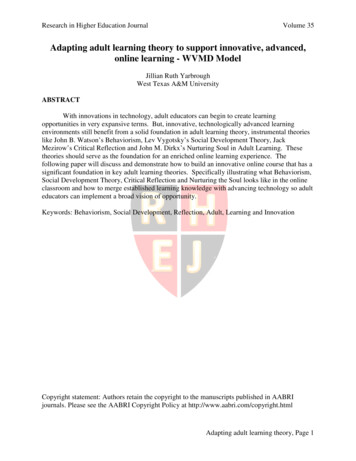
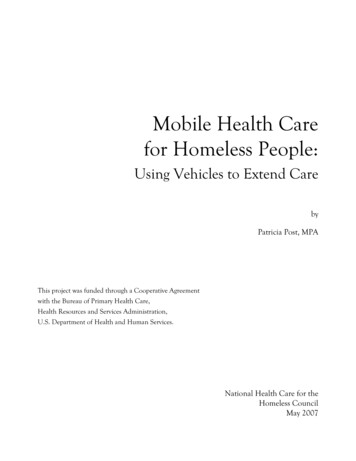
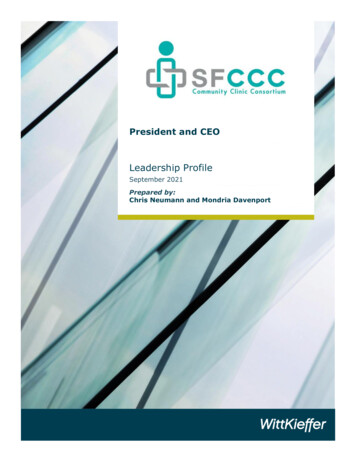
![Welcome [nhchc ]](/img/28/nhchc-partnerpha.jpg)
